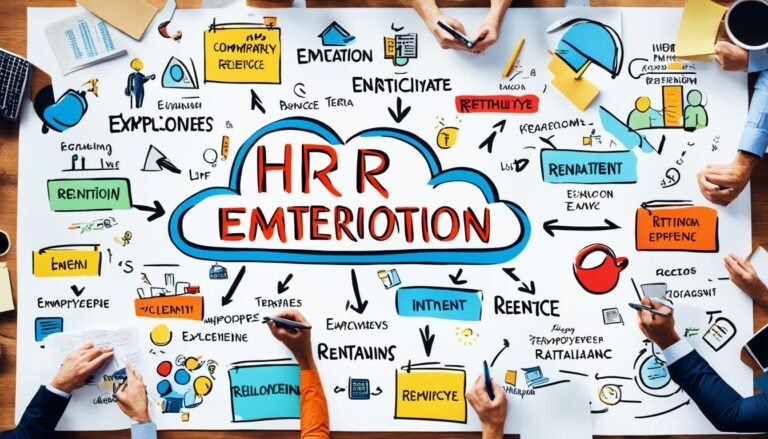A Guide to HR Employee Lifecycle
The HR employee lifecycle plays a crucial role in talent management and employee retention. Understanding and effectively managing each stage is essential for optimizing employee experience and productivity.
Key Takeaways:
- The HR employee lifecycle is vital for talent management and employee retention.
- Managing each stage of the HR employee lifecycle is crucial for maximizing employee experience and productivity.
- Optimizing the employee lifecycle helps organizations attract and retain top talent.
What is the Employee Life Cycle?
The employee life cycle encompasses the entire relationship between an employee and their organization. It includes the different stages an employee goes through from the moment they are hired to when they leave. This model helps visualize the employee-employer relationship and ensures that employees have a positive experience in each phase.
At each stage of the employee life cycle, organizations have the opportunity to shape the employee-employer relationship and nurture a productive and engaged workforce. Let’s explore the stages of the employee life cycle:
- Attraction: This stage focuses on attracting potential candidates to the organization by establishing a strong employer brand and promoting the organization’s values and culture.
- Recruitment: In this stage, the organization identifies and selects the best-fit candidates from the pool of interested individuals. It involves creating a recruitment plan, conducting interviews, and assessing candidates’ suitability for the role.
- Onboarding: This is the stage where new employees are introduced to the organization, its processes, and its expectations. A well-designed onboarding program ensures a smooth transition and sets the foundation for success in the role.
- Retention: Retention focuses on keeping employees satisfied and engaged within the organization. It involves strategies such as recognizing employee contributions, providing growth opportunities, and creating a positive work environment.
- Development: The development stage helps employees enhance their skills and capabilities through training, mentorship, and career advancement opportunities. It contributes to their professional growth within the organization.
- Offboarding: When employees leave the organization, the offboarding stage ensures a smooth transition and fosters positive relationships. It includes exit interviews and knowledge transfer to minimize the impact of losing valuable talent.
- Happy Leavers: The final stage acknowledges the value of former employees and maintains a positive relationship with them, even after they have left the organization. Building alumni networks and keeping in touch can yield future benefits.
The employee life cycle is not a linear process, but rather a continuous cycle that organizations should actively manage. By understanding and optimizing each stage, organizations can foster a positive employee experience, enhance productivity, and strengthen the employee-employer relationship.
Why is the Employee Life Cycle Important?
The employee life cycle plays a crucial role in effective human capital management. By understanding and addressing the different stages of the employee life cycle, organizations can develop strategies to meet employee needs, optimize productivity, and enhance engagement.
During each stage of the employee life cycle, from attraction to happy leavers, organizations have the opportunity to create policies and procedures that support employee growth and development. This ultimately contributes to a positive employee experience and ensures that employees feel valued and motivated throughout their journey with the organization.
By investing in the employee life cycle, organizations can not only attract and retain top talent but also foster a culture of continuous improvement and achievement. Understanding the specific needs of employees at each stage allows for targeted interventions and initiatives, which can boost productivity, increase engagement, and drive overall organizational success.
The Benefits of Focusing on the Employee Life Cycle:
- Improved employee satisfaction and well-being
- Enhanced productivity and performance
- Increased employee engagement and motivation
- Reduced turnover and improved retention rates
- Effective talent management and succession planning
By recognizing the importance of the employee life cycle, organizations can create a positive work environment that meets the diverse needs of their employees. Investing in the employee life cycle is not only essential for attracting and retaining top talent but also for cultivating a culture of continuous growth and development. This ultimately leads to higher productivity, engagement, and long-term success.
To illustrate the significance of the employee life cycle, let’s take a look at the following table:
| Stage | Key Focus | Objectives |
|---|---|---|
| Attraction | Employer branding and candidate attraction | Attracting the right candidates who align with the organization’s values and goals |
| Recruitment | Identifying and selecting the best candidates | Ensuring a skilled and diverse workforce |
| Onboarding | Integration and setting new hires up for success | Facilitating a smooth transition into the organization and fostering engagement |
| Retention | Promoting employee satisfaction and engagement | Maintaining a motivated and committed workforce |
| Development | Providing opportunities for growth and advancement | Enhancing employee skills, knowledge, and career progression |
| Offboarding | Managing the exit process with professionalism | Evaluating reasons for departure and gathering feedback for improvement |
| Happy Leavers | Ensuring positive departures and alumni engagement | Preserving positive relationships and potential future rehires or referrals |
The Stages of the Employee Life Cycle
The employee life cycle consists of seven stages, each with its own focus and objectives. These stages include attraction, recruitment, onboarding, retention, development, offboarding, and happy leavers. Each stage plays a critical role in the overall success of the organization and requires specific strategies and actions.
Attraction
The attraction stage focuses on drawing the attention of potential candidates to the organization. It involves creating a compelling employer brand and communicating the organization’s culture, values, and opportunities. By attracting the right candidates, organizations can build a strong talent pool.
Recruitment
Recruitment is the stage where organizations identify and select the best-suited candidates to join their workforce. It involves designing effective recruitment strategies, leveraging various channels to reach potential candidates, and implementing candidate selection processes. Employee referrals and involving current employees in the recruitment process can also help identify qualified candidates.
Onboarding
The onboarding stage focuses on integrating new employees into the organization and setting them up for success. It includes providing necessary training, resources, and clear communication of job expectations. Effective onboarding ensures that new employees feel welcomed, supported, and ready to contribute to the organization.
Retention
Retention is crucial for maintaining a motivated and engaged workforce. This stage involves understanding employee needs, implementing relevant rewards and recognition programs, and creating a positive work environment. By prioritizing employee satisfaction and engagement, organizations can reduce turnover and retain top talent.
Development
The development stage aims to provide employees with opportunities to grow and enhance their skills. It includes offering training programs, clear career paths, and mentorship opportunities. By investing in employee development, organizations can foster a culture of continuous learning and ensure that employees reach their full potential.
Offboarding
Offboarding refers to the process of transitioning employees out of the organization. It includes conducting exit interviews, ensuring a smooth departure, and collecting feedback for improvement. Effective offboarding helps maintain positive relationships with departing employees and can contribute to employer branding.
Happy Leavers
The stage of happy leavers emphasizes the importance of maintaining positive relationships with former employees. It involves alumni programs, networking opportunities, and staying connected to leverage their expertise and potential future collaboration.
| Stage | Focus | Objectives |
|---|---|---|
| Attraction | Draw attention of potential candidates | Build a strong talent pool |
| Recruitment | Identify and select qualified candidates | Build a skilled and diverse workforce |
| Onboarding | Integrate new employees, provide necessary resources | Facilitate a smooth transition and improve engagement |
| Retention | Maintain employee satisfaction and engagement | Reduce turnover, retain top talent |
| Development | Provide growth opportunities and improve skills | Foster continuous learning and maximize potential |
| Offboarding | Ensure smooth departure and collect feedback | Maintain positive relationships and employer branding |
| Happy Leavers | Maintain positive relationships with former employees | Leverage expertise and potential collaboration |
The Importance of Attraction
The attraction stage of the employee life cycle is a crucial step in finding candidates who align with the organization’s mission and values. To successfully attract high-quality talent, organizations must focus on employer branding, candidate attraction strategies, and employer brand perception.
Employer branding plays a significant role in attracting top candidates. A strong employer brand communicates the company’s culture, values, and unique selling points. It helps create a positive perception of the organization, making it more appealing to potential candidates.
Utilizing effective HR marketing tactics is essential in candidate attraction. This includes leveraging various channels such as job boards, social media, and professional networks to reach a wide pool of candidates. By employing targeted marketing strategies, organizations can engage with the right candidates and increase their chances of attracting top talent.
Communicating the organization’s culture and values is another crucial aspect of candidate attraction. Candidates want to know what to expect from the workplace and if it aligns with their own values and goals. By clearly communicating the company’s culture and values during the attraction stage, organizations can attract candidates who are a good fit culturally, resulting in better employee satisfaction and retention.
| Employer Branding | Candidate Attraction | Employer Brand Perception |
|---|---|---|
| Build a strong employer brand | Utilize targeted marketing tactics | Communicate organization’s culture and values |
| Enhance organization’s reputation | Engage with potential candidates through various channels | Create a positive perception of the organization |
| Showcase unique selling points | Attract candidates who align with the organization’s mission | Improve candidate’s perception of the organization |
The Role of Recruitment
During the recruitment stage of the HR employee lifecycle, organizations focus on finding and selecting the right candidates to join their team. This crucial step involves creating a recruitment plan, identifying the desired qualities and skills in candidates, and utilizing various channels to reach potential candidates.
One effective strategy in the recruitment process is the implementation of referral programs. By encouraging current employees to refer qualified candidates, organizations can tap into their network and potentially find candidates who align with the company’s values and culture.
Furthermore, involving current employees in the recruitment process can provide valuable insights and perspectives. They can participate in candidate interviews, assessments, and evaluations, contributing to a more comprehensive evaluation of candidates.
Through a well-defined recruitment process, organizations can ensure that they attract and select candidates who possess the necessary qualifications and fit well within the company culture. By leveraging referral programs and involving current employees, organizations increase their chances of finding the right talent to contribute to their success.
The Significance of Onboarding
The onboarding stage plays a crucial role in the employee life cycle, as it focuses on integrating new employees into the organization’s culture and setting them up for long-term success. Effective onboarding is key to creating a positive and productive work environment.
During the onboarding process, clear communication of expectations is essential. New hires should have a comprehensive understanding of their roles, responsibilities, and performance metrics. This ensures that they can align their efforts with organizational goals right from the beginning.
Providing necessary training and resources is another critical aspect of onboarding. Through proper training, new employees can develop the skills, knowledge, and confidence required to excel in their positions. Access to relevant resources further enables them to perform their tasks efficiently.
A smooth transition into the new role is vital for new hire retention. By creating a supportive and welcoming environment, organizations can help new employees feel valued and connected. Assigning them a mentor or buddy can facilitate employee integration by providing guidance, support, and a sense of belonging.
Research shows that effective onboarding can significantly improve new hire retention rates. When new employees feel supported and well-prepared, they are more likely to stay with the organization in the long run. New hire retention is critical for organizations seeking to maintain a stable workforce and reduce the costs associated with frequent turnover.
“Onboarding is a critical bridge that connects the recruitment process to employee integration and long-term success. It sets the foundation for employee engagement and fosters a positive employee experience.”
The Benefits of Effective Onboarding
Implementing a well-designed onboarding process offers numerous benefits for both employees and the organization:
- Improved employee satisfaction and engagement
- Increased productivity and performance
- Accelerated time to proficiency
- Reduced time and cost spent on rehiring and retraining
- Enhanced organizational culture and teamwork
By prioritizing the onboarding stage, organizations can ensure that new employees feel welcomed, supported, and equipped with the necessary tools to excel in their roles. This proactive approach ultimately contributes to improved overall employee integration and long-term retention.
| Key Components of Effective Onboarding | Benefits |
|---|---|
| Clear communication of expectations | Ensures alignment with organizational goals |
| Comprehensive training and resources | Enhances job performance and confidence |
| Smooth transition into the new role | Promotes employee integration and retention |
| Assigning a mentor or buddy | Provides guidance, support, and a sense of belonging |
The Impact of Retention
Employee satisfaction, rewards and recognition, and employee turnover play a crucial role in the retention of employees. Creating a positive work environment and understanding employee needs are essential factors in ensuring their satisfaction and engagement in their roles. When employees feel valued and appreciated, they are more likely to remain loyal to the organization, contributing to lower turnover rates and increased productivity.
The Importance of Employee Satisfaction
Employee satisfaction directly impacts their level of commitment and motivation. When employees are satisfied, they are more engaged in their work, which leads to higher productivity and better performance. Organizations can improve employee satisfaction by implementing strategies such as providing a fair and competitive compensation package, offering opportunities for growth and development, and fostering a positive work-life balance.
Rewards and Recognition as Motivators
Rewards and recognition play a significant role in promoting employee satisfaction and engagement. Recognizing and rewarding employees’ achievements and contributions reinforces positive behavior and motivates them to continue performing at their best. Whether it’s through monetary incentives, public acknowledgment, or career advancement opportunities, rewards and recognition programs help create a culture of appreciation and drive employee loyalty.
“Recognizing employees’ efforts and providing them with rewards not only boosts their morale but also instills a sense of belonging and loyalty.”
The Impact of Employee Turnover
Employee turnover can be costly and disruptive to an organization. Losing talented employees results in the loss of valuable skills, knowledge, and experience. It also affects team dynamics and can lead to decreased morale among remaining employees. By focusing on employee satisfaction and implementing effective retention strategies, organizations can minimize turnover rates and retain their top talent.
| Impact of Employee Turnover | Strategies to Improve Retention |
|---|---|
| 1. Loss of skilled employees | 1. Provide competitive compensation and benefits |
| 2. Disruption to team dynamics | 2. Develop a positive work culture |
| 3. Decreased employee morale | 3. Offer opportunities for growth and development |
| 4. Increased recruitment and training costs | 4. Foster strong leadership and communication |
By prioritizing employee satisfaction, implementing rewards and recognition programs, and addressing turnover, organizations can create a positive work environment that fosters employee engagement and loyalty. Retaining valuable employees contributes to the long-term success of the organization and ensures a motivated and productive workforce.
The Importance of Development
Development is a critical stage in the employee life cycle as it focuses on providing employees with opportunities for growth and advancement. Organizations should offer development programs, training opportunities, and clear career paths to help employees improve their skills and achieve their career goals. Continuous development can enhance employee engagement and overall performance.
Investing in employee development is not only beneficial for individuals but also for the organization. By nurturing their talent through learning and growth, companies can create a skilled and motivated workforce that drives innovation and success.
Employee Development Programs
One way organizations support employee development is through the implementation of employee development programs. These programs are designed to provide employees with the necessary knowledge, skills, and resources needed to excel in their roles and prepare for future career opportunities.
Employee development programs may include:
- Mentorship programs: Pairing experienced employees with those seeking guidance and career advice.
- Training workshops and seminars: Offering specialized training sessions to enhance specific job-related skills.
- Job rotation and cross-training: Providing opportunities for employees to gain experience in different roles or departments.
- Tuition reimbursement: Supporting employees in pursuing further education or professional certifications.
Career Opportunities and Clear Paths
Organizations that prioritize employee development understand the importance of career opportunities and clear paths for growth. By providing employees with a well-defined roadmap for advancement, organizations demonstrate their commitment to nurturing talent and creating a culture of continuous learning.
Clear career paths include:
- Job postings and internal promotions: Communicating available opportunities and encouraging employees to apply for positions that align with their career goals.
- Performance reviews and goal-setting: Assessing employee progress and collaboratively setting objectives to facilitate growth and development.
- Succession planning: Identifying high-potential employees and creating development plans to prepare them for future leadership roles within the organization.
Implementing effective employee development strategies not only benefits individual employees but also contributes to the overall success of the organization. It fosters a culture of learning and growth, boosts employee satisfaction and engagement, and attracts top talent who value opportunities for professional advancement.
By investing in employee development, organizations create a sustainable competitive advantage, positioning themselves as employers of choice in their industry.
Conclusion
The HR employee lifecycle is a fundamental framework for effectively managing human capital within organizations. By strategically navigating each stage of the lifecycle, organizations can attract top talent, optimize employee retention, and enhance the overall employee experience. This ultimately leads to improved performance and success for the organization.
Beginning with the attraction stage, organizations must focus on developing a strong employer brand and effectively marketing their values and culture. A well-executed recruitment process then ensures that the right candidates are selected and brings them into the organization.
Once hired, onboarding plays a vital role in integrating new employees and setting them up for long-term success. By providing clear communication, training, and support, organizations can enhance new hire retention and facilitate a smooth transition into their roles.
Employee retention, development, and offboarding are equally crucial stages in the HR employee lifecycle. By prioritizing employee satisfaction, offering growth opportunities, and ensuring a positive departure experience, organizations can foster a productive work environment and maintain a strong talent pool.
In conclusion, the different stages of the HR employee lifecycle, such as attraction, recruitment, onboarding, retention, development, offboarding, and happy leavers, are interconnected and vital for creating and sustaining a positive and thriving work environment. By embracing this lifecycle and implementing effective talent management practices, organizations can maximize employee retention, enhance the employee experience, and drive overall success.







